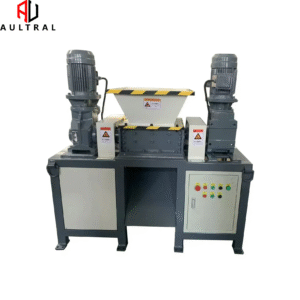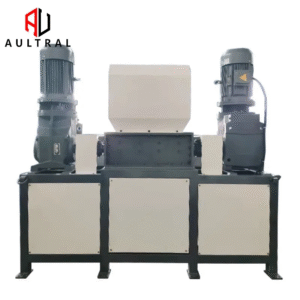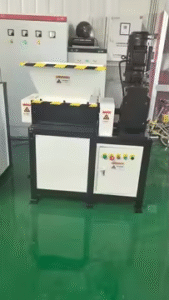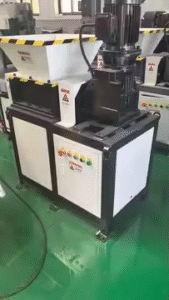In today’s fast-evolving world of industrial recycling and waste management, industrial shredders play a crucial role in processing materials efficiently, safely, and sustainably. Whether you’re dealing with metal scraps, plastic waste, tires, or wood pallets, a shredder is often the first step toward reducing volume, improving transport efficiency, and preparing materials for further processing.
In this comprehensive guide, we will explore everything you need to know about industrial shredders, including their types, key applications, advantages, and how to choose the right shredder for your needs.
What Is an Industrial Shredder?


An industrial shredder is a heavy-duty machine designed to break down solid materials into smaller, more manageable pieces. These machines use powerful rotating blades or shafts to cut, rip, or crush materials such as:
-
Scrap metals (steel, aluminum, copper)
-
Plastics (bottles, films, pipes)
-
Rubber (tires, conveyor belts)
-
Wood (pallets, crates)
-
E-waste (circuit boards, hard drives)
-
Paper and cardboard
Industrial shredders are widely used in recycling plants, metal processing yards, plastic factories, and municipal waste treatment facilities.
Types of Industrial Shredders

Shredders come in many configurations based on the materials they handle and the output size required. The main types include:
1. Single Shaft Shredder
-
Features one rotating shaft with sharp blades
-
Ideal for plastic lumps, wood, and soft metals
-
Produces relatively uniform output
-
Equipped with hydraulic pusher for consistent feeding
2. Double Shaft Shredder (Twin Shaft)
-
Two counter-rotating shafts with hooked or saw-like blades
-
Excellent for bulky and tough materials like metal drums, tires, and industrial waste
-
High torque, low speed operation
-
Known for durability and versatility
3. Four Shaft Shredder
-
Includes two primary and two secondary shafts
-
Produces finer, more uniform shredded output
-
Suitable for applications requiring precise particle size
4. Hammermill Shredder
-
Uses hammers mounted on a rotor to pulverize materials
-
Common in scrap metal recycling and e-waste processing
Each type serves specific functions and is chosen based on the material type, required output size, and processing volume.
Key Applications of Shredders

1. Metal Recycling
Industrial shredders are used to process scrap steel, aluminum sheets, car shells, appliances, and more. They reduce large, irregular items into smaller chunks that can be melted or reprocessed more easily.
2. Plastic Recycling
From PET bottles to HDPE drums and plastic films, shredders are essential in breaking down plastic into manageable flakes or granules for washing and pelletizing.
3. E-Waste Management
Shredders safely dismantle electronic waste such as circuit boards, hard drives, and cables, helping recover valuable metals while neutralizing hazardous parts.
4. Wood and Biomass Processing
Pallets, branches, and wood blocks can be shredded for use as biofuel or raw material for particle board manufacturing.
5. Municipal Solid Waste (MSW)
Shredders help reduce the volume of mixed household waste, improving landfill efficiency and preparing organic materials for composting.
Benefits of Using an Industrial Shredder
✅ Volume Reduction
Shredders significantly reduce the volume of waste, lowering storage and transportation costs.
✅ Increased Efficiency
Shredded materials are easier to handle and feed into downstream machines like granulators, balers, or melting furnaces.
✅ Material Recovery
Shredding facilitates the separation and recovery of valuable materials such as metals, plastics, and rubber.
✅ Environmental Protection
By enabling more effective recycling and reducing landfill reliance, shredders support environmental sustainability.
✅ Operational Safety
Modern shredders are designed with built-in safety features like overload protection, emergency stop, and enclosed cutting chambers.
How to Choose the Right Shredder for Your Business
Choosing the right shredder depends on several key factors:
1. Material Type
Different materials require different blade designs and torque levels. For example:
-
Soft plastics: single shaft
-
Bulky waste and metals: double shaft
-
Finer shredding: four shaft or granulators
2. Capacity and Throughput
Estimate how much material you need to process per hour or day. This determines motor power, chamber size, and feeding method.
3. Output Size
Do you need coarse chunks, uniform flakes, or fine particles? The required output size affects your choice of screen size and shredder type.
4. Space and Layout
Consider your workshop layout. Horizontal shredders require more floor space, while vertical ones may be better for limited areas.
5. Budget and Maintenance
Look for machines with low maintenance needs, accessible parts, and long-lasting blades. Cost should reflect build quality, not just price tag.
Why Choose Our Shredders?
At Aultral, we manufacture and supply a wide range of high-performance shredders tailored to industrial needs. Here’s what makes our shredders stand out:
-
✅ CE & ISO9001 certified
-
✅ 30+ years of manufacturing experience
-
✅ Heavy-duty design for long-term use
-
✅ Customizable shaft types, blade thickness, and discharge options
-
✅ Global shipping and on-site installation support
-
✅ Competitive pricing and in-stock options
Whether you’re a recycling plant, scrap yard, or plastic processor, we have the right shredder solution for your business.
Final Thoughts
An industrial shredder is more than just a piece of equipment — it’s an investment in productivity, sustainability, and profitability. As global demand for recycling and resource efficiency continues to grow, having the right shredding system in place gives your operation a clear competitive edge.
If you’re ready to upgrade your waste handling capacity or start a new recycling line, don’t hesitate to contact us for expert advice, quotations, and machine recommendations.
